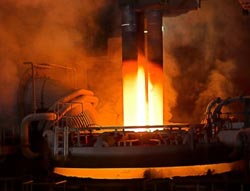An “Eye” that Measures Liquid Steel Temperatures

That’s why Siemens has developed a system called Simetal RCB Temp, which consists of an optical sensor that can determine the temperature of the molten metal in the steel production process (over 1,500 degrees Celsius) at shorter intervals than was previously the case. As a result, the best time to tap can be determined more exactly, thus saving time and energy and increasing work safety.
To produce steel in electric arc furnaces, scrap metal is melted down in a process that requires the temperature of the molten metal to be exactly and reliably measured. RCB Temp makes optimum melting sequence times possible, resulting in lower energy consumption and operating costs. Previously, the temperature had to be measured with measurement cartridges through the open slag door, because optical measurement systems are too sensitive to heat and soiling to be installed inside the furnaces. Manual measurements are strenuous, hazardous, and limit the number of measurements that can be taken until the steel is tapped. Siemens Industry has now successfully integrated the RCB (Refining Combined Burner) system into a robust optical temperature sensor.
The RCB system consists of a burner for melting the scrap metal and a lance for injecting a precisely concentrated stream of oxygen into the liquid steel. In order to measure the temperature, an inert gas is injected into the steel instead of oxygen. The gas stream enables the system to “look” into the molten metal like an eye, allowing the optical sensor at the rear of the lance to detect the liquid steel’s infrared radiation. The resulting data is used to calculate the temperature of the molten metal with the help of a special algorithm. The system doesn’t require measurement cartridges and can measure temperatures through a closed slag door and when heating power is on. And because the sensor is positioned at the rear of the lance, it is protected against damage when scrap iron is fed into the furnace.
Arc furnaces can easily be retrofitted with Simetal RCB Temp when they are shut down for maintenance. The system can increase productivity by up to two percent so that the investment is recouped in less than six months.
Media Contact
More Information:
http://www.siemens.com/innovationnewsAll latest news from the category: Power and Electrical Engineering
This topic covers issues related to energy generation, conversion, transportation and consumption and how the industry is addressing the challenge of energy efficiency in general.
innovations-report provides in-depth and informative reports and articles on subjects ranging from wind energy, fuel cell technology, solar energy, geothermal energy, petroleum, gas, nuclear engineering, alternative energy and energy efficiency to fusion, hydrogen and superconductor technologies.
Newest articles

Superradiant atoms could push the boundaries of how precisely time can be measured
Superradiant atoms can help us measure time more precisely than ever. In a new study, researchers from the University of Copenhagen present a new method for measuring the time interval,…

Ion thermoelectric conversion devices for near room temperature
The electrode sheet of the thermoelectric device consists of ionic hydrogel, which is sandwiched between the electrodes to form, and the Prussian blue on the electrode undergoes a redox reaction…

Zap Energy achieves 37-million-degree temperatures in a compact device
New publication reports record electron temperatures for a small-scale, sheared-flow-stabilized Z-pinch fusion device. In the nine decades since humans first produced fusion reactions, only a few fusion technologies have demonstrated…





















